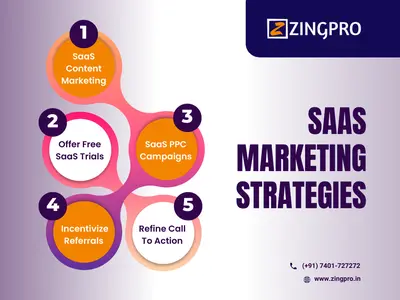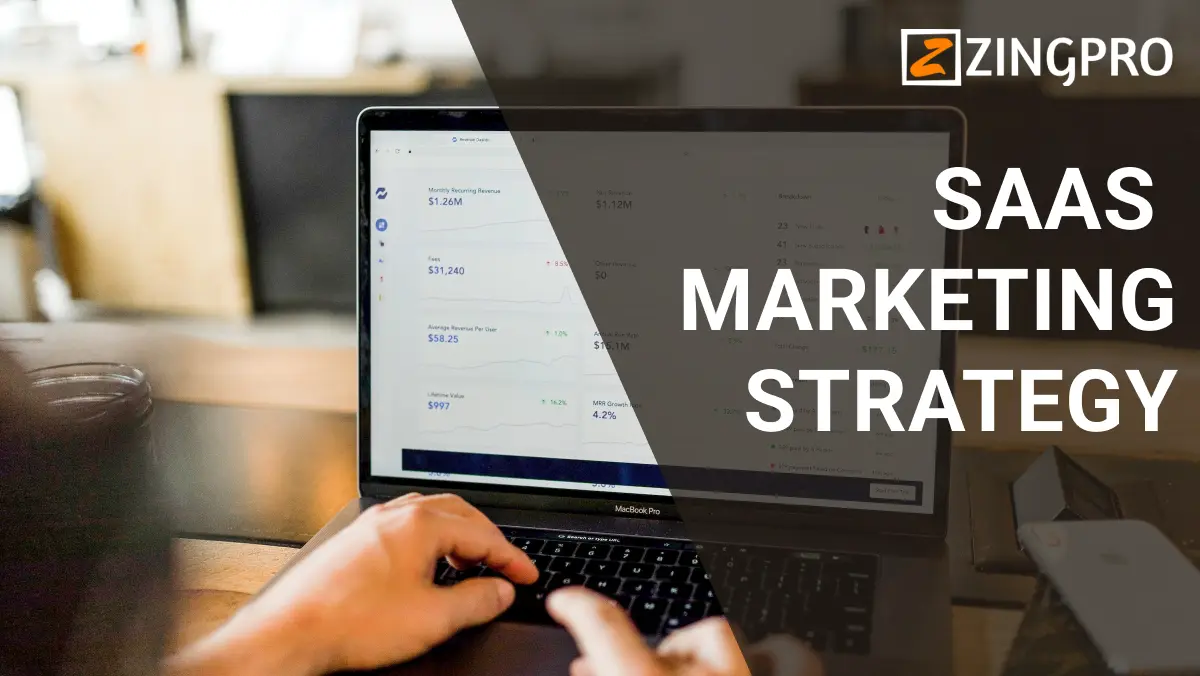A Guide to SaaS Marketing Strategy – With the rise in internet usage and advancements in telecom infrastructure, India is becoming an attractive market for SaaS companies. The favorable business environment has played a significant role in the rapid growth of the small and medium enterprise (SME) sector in India, creating abundant opportunities for SaaS solutions to thrive.
What Is SaaS Marketing?
SaaS (Software as a Service) marketing refers to the strategies and tactics used to promote, sell, and retain customers for SaaS products. It is focused on long-term customer relationships, SaaS Marketing Sales Strategy recurring revenue models, and creating value through digital services delivered online.
In contrast to traditional software marketing, where products are sold as a one-time purchase, SaaS Marketing Strategy products are typically offered on a subscription basis. This shifts the focus to customer retention, upselling, and ensuring the lifetime value of the customer. A successful SaaS marketing strategy involves educating your target audience, building trust, and offering solutions that directly address their pain points.
What Makes SaaS Marketing Unique?
SaaS Marketing Strategy is unique because it focuses not only on customer acquisition but also on customer retention and growth. Here are key factors that make SaaS marketing distinct:
- Subscription Model: The recurring revenue model requires continuous marketing efforts to keep customers engaged.
- Customer Lifetime Value (CLV): Rather than focusing on one-time sales, the goal is to maximize the long-term value of each customer.
- Ongoing Engagement: Unlike traditional product sales, where the transaction is often the end goal, SaaS marketing emphasizes customer satisfaction and retention.
- User Experience: The product’s success relies on how users interact with the service, SaaS Marketing Sales Strategy making user education and support critical elements of the strategy.
Effective SaaS marketing strategy advisors can help develop campaigns that maintain engagement, drive user adoption, and ensure customer retention, keeping the subscription cycle profitable.

10 SaaS Marketing Strategies to Level Up Your Business
To drive sustained growth and ensure long-term success, implementing a SaaS marketing strategy that focuses on both customer acquisition and retention is essential. Here are 10 SaaS marketing strategies that can elevate your business:
Content Marketing & Thought Leadership
Content is the backbone of SaaS marketing. By offering valuable, informative content like blogs, eBooks, case studies, and webinars, you can position your brand as a thought leader in your industry. This helps build trust and credibility with your audience, ultimately driving them toward conversion.
- Benefits:
- Increases organic traffic.
- Educates your audience on your product’s value.
- Establishes authority in your industry.
Search Engine Optimization (SEO)
Optimizing your website and content for search engines ensures that your product is discoverable when potential customers search for related terms. SEO for SaaS should focus on both on-page and off-page strategies, including keyword optimization, link building, and technical SEO.
- Benefits:
- Drives organic traffic.
- Improves visibility in search engines.
- Long-term sustainable growth.
Freemium Model or Free Trials
Allowing users to try out your product with a freemium model or free trial gives them the opportunity to experience the value first-hand. SaaS Marketing Strategy This lowers the barrier to entry and can be a powerful tool for customer acquisition.
- Benefits:
- Encourages more sign-ups and conversions.
- Builds trust through hands-on experience.
- Increases word-of-mouth referrals.
Customer Onboarding Process
The onboarding process is critical to customer retention. SaaS Marketing Strategy A smooth, well-designed onboarding flow ensures that new users understand how to use your SaaS product effectively, leading to higher conversion rates and reduced churn.
- Benefits:
- Improves customer satisfaction.
- Reduces churn by ensuring users realize the value quickly.
- Increases customer lifetime value (CLV).
Referral and Affiliate Programs
Referral programs incentivize your existing users to refer others, SaaS Marketing Strategy tapping into the power of word-of-mouth. Similarly, affiliate marketing allows you to partner with influencers or other companies to promote your product in exchange for a commission.
- Benefits:
- Leverages your existing customer base.
- Scales your marketing efforts without increasing budget.
- Boosts credibility through trusted referrals.
Email Marketing & Drip Campaigns
Email marketing is a powerful tool to nurture leads and engage existing customers. Using automated drip campaigns, SaaS Marketing Strategy you can deliver tailored content and offers based on customer behavior, increasing the likelihood of conversion.
- Benefits:
- Maintains engagement with leads and customers.
- Personalizes messaging to drive conversions.
- Automates the nurturing process, saving time.
Webinars & Live Demos
Webinars and live demos provide an opportunity to showcase your product’s capabilities in real-time. This interactive format allows potential customers to ask questions, SaaS Marketing Strategy see the product in action, and better understand its value.
- Benefits:
- Engages potential customers in real-time.
- Increases conversions by offering a personalized touch.
- Positions your company as an expert in your field.
Paid Advertising (PPC)
Investing in paid ads like Google Ads, Facebook Ads, or LinkedIn Ads helps you reach a broader audience quickly. By targeting specific keywords, industries, SaaS Marketing Strategy or user demographics, you can attract qualified leads who are more likely to convert.
- Benefits:
- Instant traffic and brand visibility.
- Highly targeted advertising.
- Provides measurable results for optimization.
Social Proof & Case Studies
Showcasing testimonials, reviews, SaaS Marketing Strategy and case studies from satisfied customers is a great way to build trust with potential leads. Social proof serves as validation and can significantly influence purchase decisions.
- Benefits:
- Builds trust and credibility.
- Provides tangible proof of product value.
- Helps convert hesitant leads into paying customers.
Data Analytics & A/B Testing
Using data analytics and A/B testing helps optimize your marketing efforts. By analyzing customer behavior and testing different elements of your campaigns (e.g., landing pages, calls to action), you can make data-driven decisions that improve conversion rates.
- Benefits:
- Maximizes the performance of your campaigns.
- Provides insights into customer preferences.
- Continuously improves your marketing strategy.
By integrating these strategies into your SaaS marketing sales strategy, you can effectively grow your customer base, improve retention, and boost revenue. SaaS Marketing Strategy With the right approach, your SaaS Marketing Strategy Advisors can stand out in a competitive market, driving both short-term and long-term success.
How to Measure SaaS Marketing Success?
Tracking the success of your SaaS marketing strategy requires a mix of quantitative and qualitative data to gauge your efforts. Here are a few key metrics to monitor:
- Customer Acquisition Cost (CAC): The cost involved in acquiring a new customer, including marketing and sales expenses.
- Churn Rate: The percentage of customers who cancel or don’t renew their subscriptions.
- Customer Lifetime Value (CLV): The total revenue generated by a customer over the duration of their relationship with your company.
- Monthly Recurring Revenue (MRR): The amount of predictable revenue SaaS Marketing Strategy generated monthly through subscriptions.
- Conversion Rate: The percentage of website visitors who sign up or make a purchase.
- Net Promoter Score (NPS): A metric used to measure customer satisfaction and loyalty.
SaaS product marketing strategy advisors often use these metrics to adjust campaigns, SaaS Marketing Strategy improve targeting, and increase overall effectiveness.
How to Create an Effective SaaS Marketing Strategy?
Creating an effective SaaS marketing strategy requires understanding your target audience, the unique benefits of your SaaS product, and how you can deliver value consistently. Here’s how to build a solid foundation for your strategy:
- Define Your Audience: Understand who your ideal customer is—age, industry, job titles, pain points.
- Identify Key Differentiators: What makes your SaaS product unique? Why should customers choose your solution over competitors?
- Set Clear Objectives: Align your strategy with measurable goals, such as increasing MRR or reducing churn.
- Develop Content Strategy: Plan a content strategy that aligns with your audience’s needs and your product’s value proposition.
- Optimize for Retention: Focus on customer satisfaction, engagement, and support to reduce churn and improve CLV.
Your SaaS product marketing strategy should be a dynamic framework SaaS Marketing Strategy that evolves as the market and customer preferences change.
Advanced SaaS Marketing Strategies
Once you’ve mastered the fundamentals, SaaS Marketing Strategy Advisors it’s time to implement more advanced strategies SaaS Marketing Strategy for scaling your SaaS business:
- Account-Based Marketing (ABM): Focus on highly targeted marketing efforts for specific high-value accounts.
- Advanced Email Automation: Use behavioral triggers, segmentation, and personalized messaging to optimize email campaigns.
- Interactive Content: Create quizzes, assessments, or interactive demos that engage users and provide personalized value.
- Partnerships & Integrations: Collaborate with other SaaS providers or industry tools to offer integrated solutions and tap into new customer bases.
- Product-Led Growth (PLG): Use your product itself as the primary vehicle for customer acquisition and retention, encouraging viral adoption.
By working with SaaS marketing strategy advisors, you can develop these advanced strategies and scale your SaaS business exponentially, SaaS Marketing Sales Strategy ensuring that each tactic is personalized for maximum impact.
Conclusion
SaaS Marketing Strategy, it’s essential to invest time in understanding both the market and your target audience. The key elements to focus on are your value proposition and effective positioning. At Zingpro Consulting, we bring over a decade of expertise in SaaS technologies across various industries. We’ve been in your shoes and truly understand the challenges of scaling a business. Reach out to us—let’s collaborate on creating a SaaS marketing strategy that ensures long-term success.
Read also Top 5 Sales Outsourcing Companies India.

